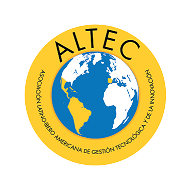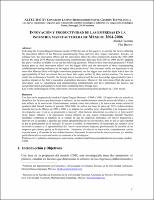| dc.contributor.author | Guzmán, Alenka | |
| dc.contributor.author | Brown, Flor | |
| dc.date.accessioned | 2021-05-27T15:55:47Z | |
| dc.date.available | 2021-05-27T15:55:47Z | |
| dc.date.issued | 2013 | |
| dc.identifier.uri | https://hdl.handle.net/20.500.13048/766 | |
| dc.description.abstract | Following the Crépon-Duguet-Mairesse model (1998) the aim of this paper is to identify the factors affecting the innovation efforts of the Mexican manufacturing firms and how they impact innovation. Besides, we estimate how this innovation efforts and the innovation affect the labor productivity during the 2004-2006 period. By using 2078 Mexican manufacturing establishments data base from 2004 to 2006 and by adapting the proxy variables available we set out the following questions: Which is their innovation propensity? Which factors push on their innovation effort? Are the bigger effort and the innovation of these manufacturing establishments having influence on the higher labor productivity? Our outcomes verify our hypothesis in the sense that Mexican firms with higher innovation propensity are the bigger ones and also those which have the appropriability of their inventions, but nor those that export neither by their market position. The access to credit, the technological transfer, the foreign direct investment and the new knowledge appropriability have a positive impact on the firm’s innovation expenditure decisions. Moreover, the innovation effort, the same as innovation, joint to exportations and manufacturing establishments size have influenced the process and design innovation, particularly in local firms comparing those foreign ones. | |
| dc.description.abstract | Con base en la propuesta del modelo Crépon-Duguet-Mairesse –CDM- (1998). El objetivo de este estudio es
identificar los factores que determinan el esfuerzo de los establecimientos manufactureros de México y cómo
éste influye en la innovación. Posteriormente, estimar cómo este esfuerzo y la innovación misma afectan la
productividad laboral durante el periodo 2004-2006. Se utiliza una base de datos de 2078 establecimientos
manufactureros de México de 2004 a 2006 y se adaptan las variables proxy disponibles. Las preguntas de la
investigación son: ¿Cuál es su propensión a innovar? ¿Qué factores determinan su esfuerzo en innovación?
¿Este mayor esfuerzo y la innovación misma influyen en una mayor productividad laboral? Nuestros
resultados confirman la hipótesis en el sentido de que las empresas mexicanas con mayor propensión a
innovar son las grandes y aquellas que tienen apropiabilidad de sus invenciones; pero no así las que exportan
ni por su participación en el mercado. El acceso al crédito, la transferencia de tecnología, los recursos de la
inversión extranjera y la apropiabilidad del nuevo conocimiento impactan positivamente la decisión de las
empresas para ejercer gastos en la innovación. Asimismo, el esfuerzo en innovación, conjuntamente con las
exportaciones y el tamaño de los establecimientos, determinó la innovación de nuevos procesos y/o diseños,
particularmente en empresas locales en contraste a las extranjeros. | |
| dc.language.iso | spa | |
| dc.rights | info:eu-repo/semantics/openAccess | |
| dc.rights | Atribución-NoComercial-SinDerivadas 2.5 Perú | |
| dc.rights.uri | http://creativecommons.org/licenses/by-nc-nd/2.5/pe/ | |
| dc.subject | Esfuerzos tecnológicos | |
| dc.subject | Innovación | |
| dc.subject | Productividad de firmas manufactureras mexicanas | |
| dc.subject | Modelo CDM | |
| dc.title | Innovación y productividad de las empresas en la industria manufacturera de México: 2004-2006 | |
| dc.type | info:eu-repo/semantics/conferenceObject | |
| dc.relation.conferencedate | 27-31 de octubre, 2013 | |
| dc.relation.conferencename | XV Congreso Latino-Iberoamericano de Gestión Tecnológica | |
| dc.relation.conferenceplace | Porto, Portugal | |
| dc.contributor.corporatename | Universidad Autónoma Metropolitana-Iztapalapa | |


